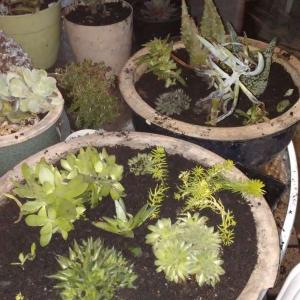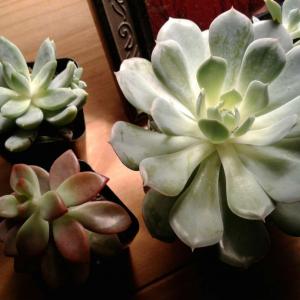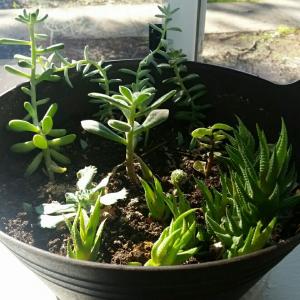求助
JustCaffeine
2017年01月29日

Could somebody please help me identify these adorable little succulents? I got these cuties for a pretty good deal at a local plant shop yesterday. They are very small, the tallest one measuring at around one inch tall. I'd just like to know if there are any particular caretaking requirements for it compared to my other succulents and cacti, and just because I like to be able to identify my plants. #succulent #help


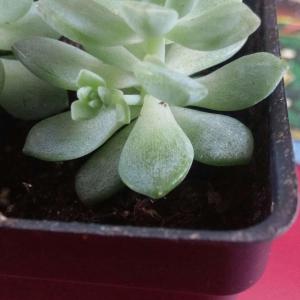



1
0
Morpheus M Clerk:looks like Ice plant but I'm not sure that's what it is precisely, from the looks of it it's ready to take over whatever area you plant it in, so be ready for that!
Clair-Lee:It seems that it was over water and lack of sunlight. In my opinion, you should take care of it just like your other Echeveria. One or two months later, it may look different and you can distinguish it easier.
小心翼翼:Oh,good looking
绿手指干货:More sunshine, less water, is so esay!
求助
Tazzydevyl
2017年01月01日

This is one of my succulents the plant tag says it is Mammillaria elongata or "Little suns". Is it perhaps called something else?

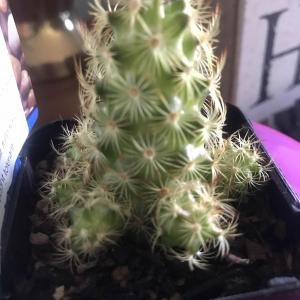


6
0
我是小花:@Tazzydevyl Yes! You can go to the App Store search WeChat download, we are here waiting for you!
文慧~瑞士:@Tazzydevyl ok...you can go APP download “wechat”..... Join my friends....my wechat ID ...470554259....Then I add you to our group....ok?
Tazzydevyl:@文慧~瑞士 no I do not have wechat I will have to find out what that is.
文慧~瑞士:@Tazzydevyl Do you have wechat?you can every question wechat!
Tazzydevyl:Thank you after I googled silver fingers it doesn't look like my one.....I guess little suns is the correct name, or the name given in Australia.
显示更多
成长记
rebeccamee
2016年12月29日

I new added a "My collection of succulents - all potted" in my "garden"
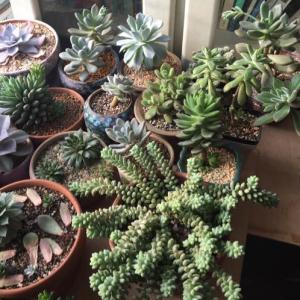

0
0
rebeccamee:嗯嗯,不少
紫童:你也养很多哈
文章
stone
2016年12月29日
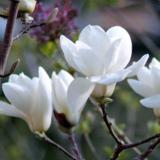
#suncculents #winter Succulents are such a popular and easy to care for plant these days.However, a freeze thaw / climate and snow generally is not a succulents best friend.
1. Watering
Pour water into the top of the succulent container until it drains out the bottom. Water the succulents deeply but less often in the winter. Let the soil dry out completely before watering again.
2. Sunlight
Succulents survive with indirect light during the winter.Place the dormant succulent in an area with at least three to four hours of bright light.Usually try to do this a couple of days a week during winter.
3. Temperature
When the temperature outdoors starts to cool below 60 degrees Fahrenheit start tapering off with watering.Bring your succulents inside when outside temps hit 40 degrees. Keep the temperature of the room the succulents are in around 50 to 55 degrees Fahrenheit during the winter. Many succulents such as aeoniums and living stones do not tolerate colder temperatures.
4. Check frequently for bugs
I've heard through other gardeners that 3 parts rubbing alcohol and 1 part water can be wiped onto any succulent that may develop aphids over winter.
You can use a cotton ball or a soft paper towel to apply it and make sure to check underneath the leaves. Also make sure to separate that plant from others until the aphids are completely gone.
5. Feeding
Feed the succulents one last time at the end of summer. Succulents only need diluted fertilizer while they are actively growing. Stop feeding when the plants stop growing for the year and go dormant, which occurs when the temperatures drop and the light level falls. Too much fertilizer causes succulents to develop soft leaves, which are prone to rot.

1. Watering
Pour water into the top of the succulent container until it drains out the bottom. Water the succulents deeply but less often in the winter. Let the soil dry out completely before watering again.

2. Sunlight
Succulents survive with indirect light during the winter.Place the dormant succulent in an area with at least three to four hours of bright light.Usually try to do this a couple of days a week during winter.

3. Temperature
When the temperature outdoors starts to cool below 60 degrees Fahrenheit start tapering off with watering.Bring your succulents inside when outside temps hit 40 degrees. Keep the temperature of the room the succulents are in around 50 to 55 degrees Fahrenheit during the winter. Many succulents such as aeoniums and living stones do not tolerate colder temperatures.

4. Check frequently for bugs
I've heard through other gardeners that 3 parts rubbing alcohol and 1 part water can be wiped onto any succulent that may develop aphids over winter.
You can use a cotton ball or a soft paper towel to apply it and make sure to check underneath the leaves. Also make sure to separate that plant from others until the aphids are completely gone.

5. Feeding
Feed the succulents one last time at the end of summer. Succulents only need diluted fertilizer while they are actively growing. Stop feeding when the plants stop growing for the year and go dormant, which occurs when the temperatures drop and the light level falls. Too much fertilizer causes succulents to develop soft leaves, which are prone to rot.
7
2
文章
stone
2016年12月28日

#lithops #living-stone #succulent Living Stones (Lithops) are unusual succulents that have evolved to resemble the pebbles and rocks that litter their native habitats through southern Africa. These very small plants hug the ground and grow extremely slowly. It can take years for a plant to eventually fill its pots with new leaves. Structurally, Lithops are comprised of two fused leaves above ground that connect to an underground stem with a long root.
The leaves are extremely thick and the degree of fusion depends on the species. Some species appear to be a single leaf, with hardly any evidence of the leaf fusion, while others are deeply lobed to the level of the soil. These plants are great collectibles, but require a careful hand with the water. Too much water and the leaves will burst or the plant will die from beneath. If you provide them with good conditions, they will flower in mid-to late summer with white and yellow daisy-like flowers that emerge from between the leaves.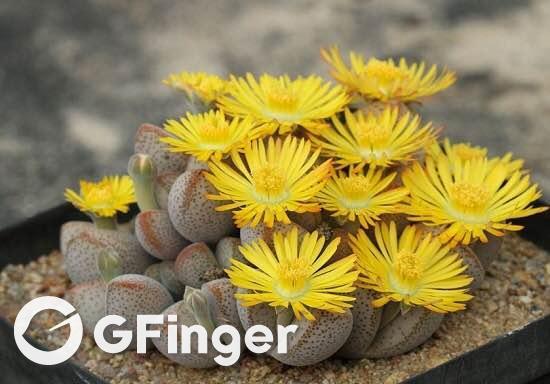
Growing Conditions
Light: Lithops thrive in full sunlight, so provide as much light as possible. Weak light will cause elongated leaves and washed out patterns on the leaves.
Water: Lithops have a definite annual cycle that should be carefully followed. In the summer, as the plants are dormant, it is okay to lightly water them if the leaves shrivel. In general, plants should not be watered during their summer dormancy or during the winter.
Temperature: Warm in summer (household temperatures are fine) and colder in winter months (down to 55˚F/13˚C at night).
Soil: Use a cactus mix or very fast-draining potting soil mixed with sand.
Fertilizer: Fertilizer is not necessary.
Propagation
Most Lithops species can be propagated from seeds. Seedlings typically take two to three years to reach maturity and begin flowering.
Repotting
Lithops are very slow growing, small plants, which makes them ideal as houseplants (once you get the hang of their watering schedule). Older plants form attractive clumps of “pebbles” in their pots, which are highly prized. In general, plants should only be repotted if there are cultural problems (soggy soil) or the plant has outgrown its dish container, which will only happen every several years。
Grower’s Tips
Lithops develop a new set of leaves every year, with new leaves emerging in the fall and growing through the winter and into the summer. In late summer, the plant will go dormant and water should be severely restricted to prevent bursting leaves. The flowers appear near the end of summer or fall, first showing up as a small bud forcing its way between the leaves and growth will begin again. It’s safe to water during this period. Heading into the winter, the leaves will still be growing, but you should stop watering, even as the older leaves shrivel up and encase the new growth. In the spring, it’s safe to begin lightly watering again as the plant begins to grow again, heading toward their summer dormancy period and the emergence of new leaves in the fall.

The leaves are extremely thick and the degree of fusion depends on the species. Some species appear to be a single leaf, with hardly any evidence of the leaf fusion, while others are deeply lobed to the level of the soil. These plants are great collectibles, but require a careful hand with the water. Too much water and the leaves will burst or the plant will die from beneath. If you provide them with good conditions, they will flower in mid-to late summer with white and yellow daisy-like flowers that emerge from between the leaves.

Growing Conditions
Light: Lithops thrive in full sunlight, so provide as much light as possible. Weak light will cause elongated leaves and washed out patterns on the leaves.
Water: Lithops have a definite annual cycle that should be carefully followed. In the summer, as the plants are dormant, it is okay to lightly water them if the leaves shrivel. In general, plants should not be watered during their summer dormancy or during the winter.
Temperature: Warm in summer (household temperatures are fine) and colder in winter months (down to 55˚F/13˚C at night).
Soil: Use a cactus mix or very fast-draining potting soil mixed with sand.
Fertilizer: Fertilizer is not necessary.

Propagation
Most Lithops species can be propagated from seeds. Seedlings typically take two to three years to reach maturity and begin flowering.
Repotting
Lithops are very slow growing, small plants, which makes them ideal as houseplants (once you get the hang of their watering schedule). Older plants form attractive clumps of “pebbles” in their pots, which are highly prized. In general, plants should only be repotted if there are cultural problems (soggy soil) or the plant has outgrown its dish container, which will only happen every several years。

Grower’s Tips
Lithops develop a new set of leaves every year, with new leaves emerging in the fall and growing through the winter and into the summer. In late summer, the plant will go dormant and water should be severely restricted to prevent bursting leaves. The flowers appear near the end of summer or fall, first showing up as a small bud forcing its way between the leaves and growth will begin again. It’s safe to water during this period. Heading into the winter, the leaves will still be growing, but you should stop watering, even as the older leaves shrivel up and encase the new growth. In the spring, it’s safe to begin lightly watering again as the plant begins to grow again, heading toward their summer dormancy period and the emergence of new leaves in the fall.
4
3
rebeccamee:Not so familiar with this plant but they look cute, will give it a thought to grow them if I have more room to keep all my succulents



